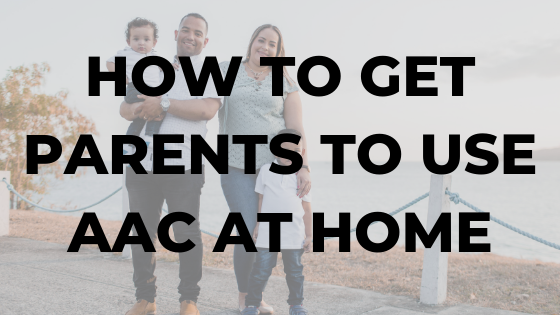I remember one of the first times I had a student who used a high-tech voice output device.
Getting the district to pay for the device was a huge hurdle, and I’d managed to overcome it.
Little did I know I had a huge roadblock still ahead.
By the time the shiny new device had come in, I’d already completed three graduate-level courses that covered AAC, and had even spent several semesters teaching one.
You would have thought I had all my bases covered…but I didn’t.
I was finally feeling a little more prepared to work with students with severe communication needs.
What I wasn’t prepared for was the parents.
My student was a second grader with limited intelligible speech.
We could tell that she WANTED badly to communicate by the way she’d try to engage in real back and forth exchanges.
She could even pair 5-6 words together using picture symbols.
All the skills were there, and I’d covered all my bases to make sure this student had the skills to navigate through multiple screens on a device with different messages.
I’d made my decision that a high-tech device was the best option, and I was pretty confident in that decision.
I’d spent hours researching what type of device would be best and I thought I had all the answers.
The problem was that I didn’t bother to see if her parents agreed.
“We just want her to talk like our other kids,” they said. “We’re not sure we like that machine thing.”
I knew few people could understand her besides her immediate family.
I knew that every day she came to school, she couldn’t have a conversation with her friends or share an answer in class.
She couldn’t ask us for help.
She couldn’t even tell us when she had to go to the bathroom.
I had a solid therapy plan I knew was backed by research, and if everyone just did what they were “supposed” to do it would have worked wonders.
So my student’s $8000 device got left on the shelf all year and parents never used it at home EVER.
The best plan in the world won’t work if your team won’t follow through with it, and parents are the most important team members of all.
The challenge for us comes when our recommendations don’t line up with what families want.
And we know forcing our recommendations down their throat won’t work.
It can be like walking on egg shells.
Here’s where a lot of us get stuck.

We may not learn to deal with sensitive situations in our SLP training, and we aren’t always prepared when it happens in real life.
That’s when we wonder if we’re really cut out for this.
We may tell ourselves we’re just not good with negotiating and confrontation.
We think, “Maybe I’m just not a people person”, and assume there isn’t anything we can do about it.
But the good news is that you CAN do something about it.
If you’re telling yourself you’re just “not good with people”, or that you’re “socially awkward”…you don’t have to stay that way forever (and it may not even be true).
I actually shared ways to work through this challenge on one of our recent SLP Learning Academy Q & A Coaching Calls.
On the call, I share:
✅Why being “nice” and validating people’s feelings too much can kill your chances of getting buy-in.
✅What to say at the beginning of the meeting to keep the meeting focused and on track.
✅How to hold stakeholders accountable without being pushy or condescending.
✅How to help stakeholders convince themselves they to follow your advice.
✅How to get parents/clients to consistently follow-through on what’s in their best interest.
You can watch the call here.
You’ll want to check it out if you’ve ever:
…Struggled to get a teacher to follow through with classroom accommodations…
…Needed to convince a student to do home practice outside of therapy sessions…
…Struggled to get teachers or parents to use AAC with children outside of therapy…
…Had students who don’t show up to speech on purpose…
…Had parents who’ve questioned your therapy goals…
You can check out this segment of the exclusive coaching call here.
Parent buy-in and AAC are just a couple of the topics we’ve covered in our member Q & A calls.
This past couple months, we’ve also covered things like how to:
👍Get teachers to buy-in to classroom accommodations/language facilitation techniques.
👍Support literacy growth in young children with parents who don’t speak English.
👍Interview people in a way that motivates them to follow through on your recommendations.
👍Support secondary students with conditions like ADHD and ASD, including writing-goals.
👍Handle scheduling logistics so you can do more classroom-based therapy.
👍Navigate the RtI process with ease as an SLP supporting school-aged children.

